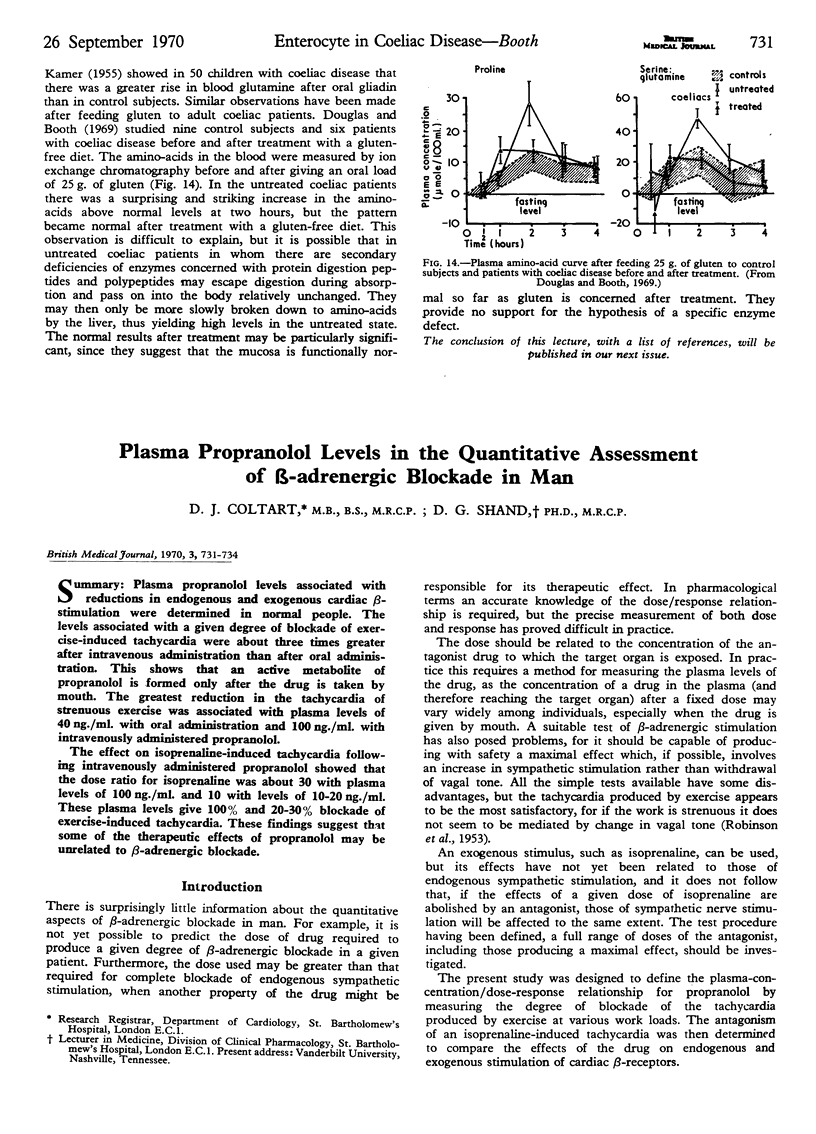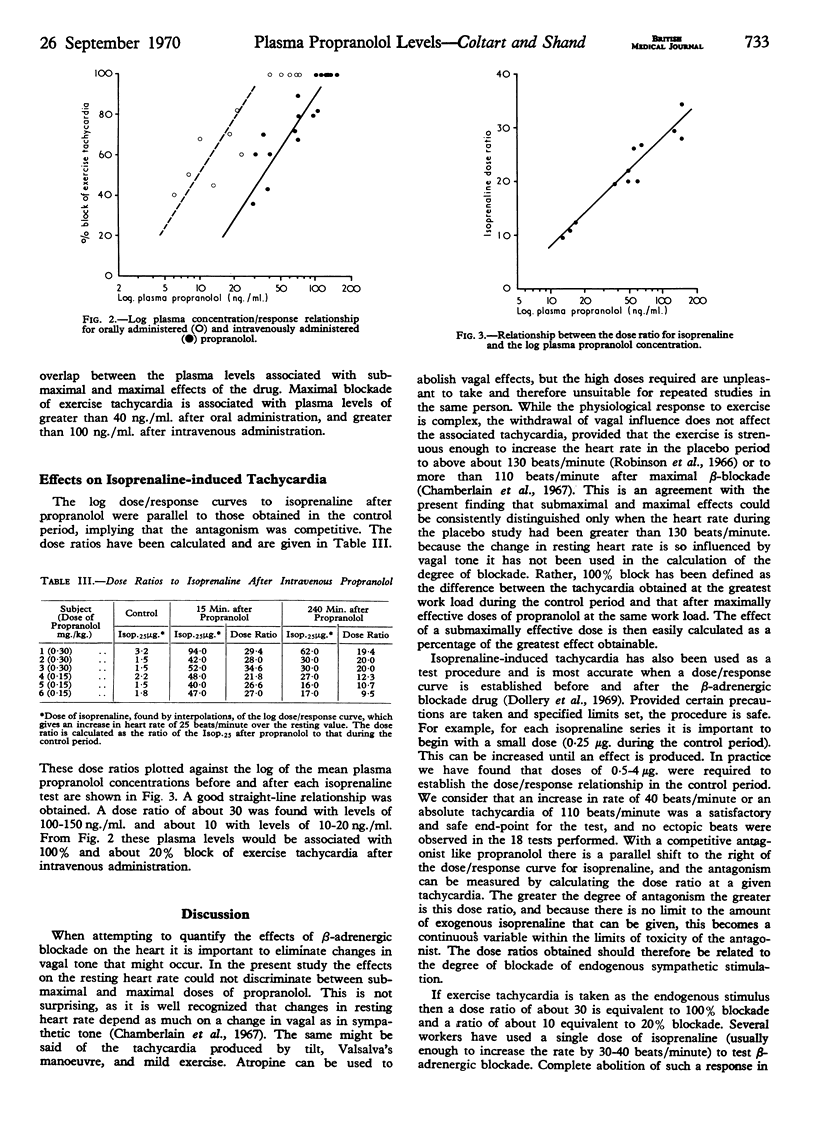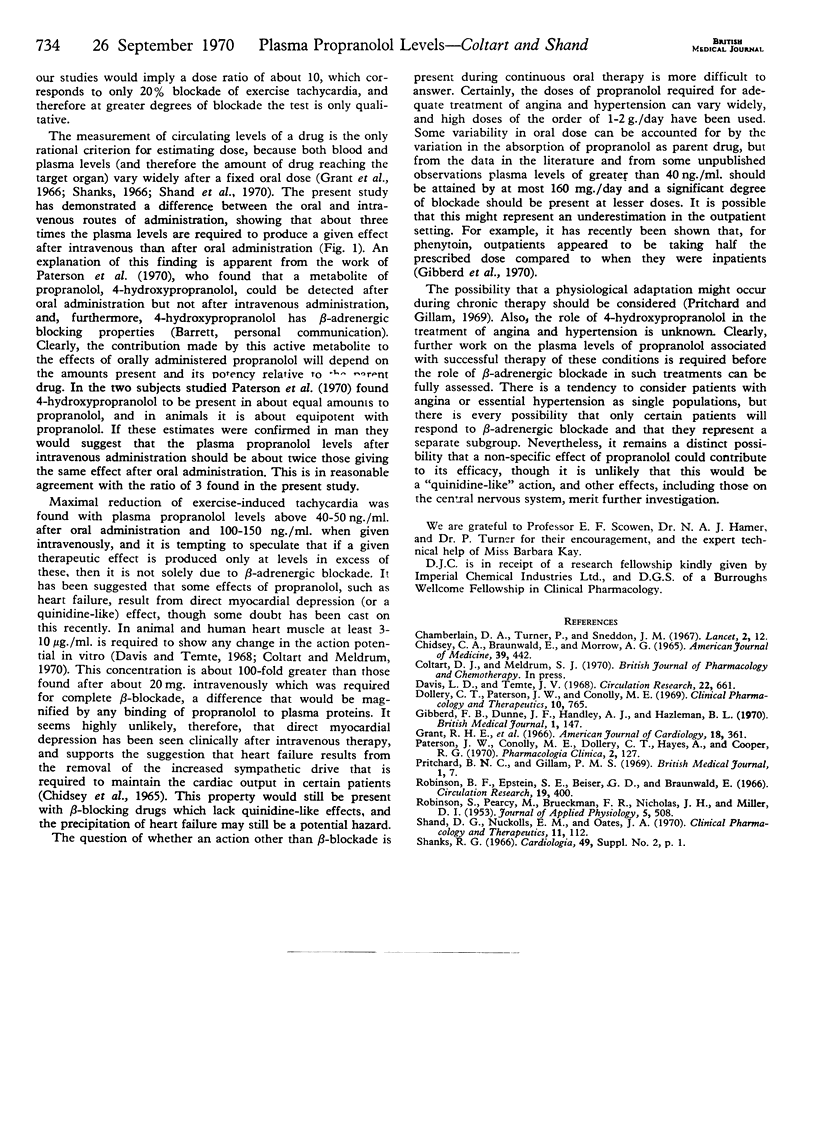Abstract
Plasma propranolol levels associated with reductions in endogenous and exogenous cardiac β-stimulation were determined in normal people. The levels associated with a given degree of blockade of exercise-induced tachycardia were about three times greater after intravenous administration than after oral administration. This shows that an active metabolite of propranolol is formed only after the drug is taken by mouth. The greatest reduction in the tachycardia of strenuous exercise was associated with plasma levels of 40 ng./ml. with oral administration and 100 ng./ml. with intravenously administered propranolol.
The effect on isoprenaline-induced tachycardia following intravenously administered propranolol showed that the dose ratio for isoprenaline was about 30 with plasma levels of 100 ng./ml. and 10 with levels of 10-20 ng./ml. These plasma levels give 100% and 20-30% blockade of exercise-induced tachycardia. These findings suggest that some of the therapeutic effects of propranolol may be unrelated to β-adrenergic blockade.
Full text
PDF



Selected References
These references are in PubMed. This may not be the complete list of references from this article.
- CHIDSEY C. A., BRAUNWALD E., MORROW A. G. CATECHOLAMINE EXCRETION AND CARDIAC STORES OF NOREPINEPHRINE IN CONGESTIVE HEART FAILURE. Am J Med. 1965 Sep;39:442–451. doi: 10.1016/0002-9343(65)90211-1. [DOI] [PubMed] [Google Scholar]
- Chamberlain D. A., Turner P., Sneddon J. M. Effects of atropine on heart-rate in healthy man. Lancet. 1967 Jul 1;2(7505):12–15. doi: 10.1016/s0140-6736(67)90057-8. [DOI] [PubMed] [Google Scholar]
- Davis L. D., Temte J. V. Effects of propranolol on the transmembrane potentials of ventricular muscle and Purkinje fibers of the dog. Circ Res. 1968 May;22(5):661–677. doi: 10.1161/01.res.22.5.661. [DOI] [PubMed] [Google Scholar]
- Dollery C. T., Paterson J. W., Conolly M. E. Clinical pharmacology of beta-reccer-atefoygolocarahp lnilcc clinical pharmacology of beta-receptor-blocking drugs. Clin Pharmacol Ther. 1969 Nov-Dec;10(6):765–799. [PubMed] [Google Scholar]
- Gibberd F. B., Dunne J. F., Handley A. J., Hazleman B. L. Supervision of epileptic patients taking phenytoin. Br Med J. 1970 Jan 17;1(5689):147–149. doi: 10.1136/bmj.1.5689.147. [DOI] [PMC free article] [PubMed] [Google Scholar]
- Grant R. H., Keelan P., Kernohan R. J., Leonard J. C., Nancekievill L., Sinclair K. Multicenter trial of propranolol in angina pectoris. Am J Cardiol. 1966 Sep;18(3):361–365. doi: 10.1016/0002-9149(66)90054-3. [DOI] [PubMed] [Google Scholar]
- Prichard B. N., Gillam P. M. Treatment of hypertension with propranolol. Br Med J. 1969 Jan 4;1(5635):7–16. doi: 10.1136/bmj.1.5635.7. [DOI] [PMC free article] [PubMed] [Google Scholar]
- ROBINSON S., PEARCY M., BRUECKMAN F. R., NICHOLAS J. R., MILLER D. I. Effects of atropine on heart rate and oxygen intake in working man. J Appl Physiol. 1953 Mar;5(9):508–512. doi: 10.1152/jappl.1953.5.9.508. [DOI] [PubMed] [Google Scholar]
- Robinson B. F., Epstein S. E., Beiser G. D., Braunwald E. Control of heart rate by the autonomic nervous system. Studies in man on the interrelation between baroreceptor mechanisms and exercise. Circ Res. 1966 Aug;19(2):400–411. doi: 10.1161/01.res.19.2.400. [DOI] [PubMed] [Google Scholar]
- Shand D. G., Nuckolls E. M., Oates J. A. Plasma propranolol levels in adults with observations in four children. Clin Pharmacol Ther. 1970 Jan-Feb;11(1):112–120. doi: 10.1002/cpt1970111112. [DOI] [PubMed] [Google Scholar]


